Call us
FAQ
Section Heading
1- Who are our patients ?
Our protocols and techniques are catered for :
- Patients who wish to protect their teeth in order to prevent infections rather than seek care only when infections occur.
- Patients with warning signs such as bad breath, bleeding/receding gums or loose teeth for whom no previous treatment helped
- Patients with recurring conditions – even within the close family – and/or a history of tooth loss.
- Patients with an existing condition, even severe, who wish to heal effectively using a conservative non-surgical method.
- Patients that went through methods based on deep cleaning, scaling or even surgery and nevertheless still have a periodontal condition.
- Patients who traveled to exotic countries and might have been infected by parasites.
2- My gums bleed from time to time when I brush my teeth, should I schedule a visit?
Absolutely. Bleeding gums while brushing is very often the only warning sign of a disease even if you don't feel any pain : this influx of blood is what fights the infectious agent.
If no action is taken to localize the source of the bleeding and treat it accordingly, the disease will only worsen as time goes by.
A healthy gum never bleeds even when brushed thoroughly.
3 - What are the symptoms of gum disease ?
The most obvious warning signs are mainly :
- Red and/or swollen gum around teeth
- Spontaneous bleeding or caused by brushing
- Bad breath
- Receding gums
- Food stuck between teeth
- New spaces between teeth and/or itching around the teeth
- Deep gum pockets
- Loose teeth
- Tooth loss
Naturally, even one of these symptoms is a good enough reason to schedule a visit with your periodontist.
Moreover, it is recommended to schedule a routine exam once a year to evaluate your dental plaque and make sure your gums stay healthy.
4- What are the stages of gum disease ?
| Stage I : | Dental plaque gradually settles on your teeth and gums, calcifies and transforms into tartar. Your gums become swollen, redden and easily bleed at the slightest contact – this is known as a gingivitis. No visible symptoms to the naked eye. |  |  |
| Stage II: | Untreated Stage I will result in Stage II The dental plaque further infects the gum with harmful bacteria. A pocket is formed between the tooth and the gum and it becomes challenging to scale the plaque at the bottom of the tooth. There might be a slight bone reduction. |  |  |
| Stage III : | Untreated Stage II will result in Stage III. Harmful bacteria and parasites multiply and bone reduction becomes more obvious. Teeth become loose. This is a "periodontal disease" with "receding gum". Significant bone reduction. |  |  |
| Stage IV: | The progressive destruction of the gingival and bone tissue continues, the loss of gum attachment leads to loose teeth while chewing. Eventually the tooth falls off. |  |  |
5- What to expect at your first visit ?
A) A physical exam :
a) Evaluation of your oral health: gums/teeth aspect, color, localization of any bleeding etc,
b) The dental plaque is sampled painlessly around your molars and observed through the microscope (you can opt to view the plaque sample on screen while it is being examined). Once the exact type and degree of infection has been determined (bacteria, parasites and/or fungus), your periodontist will be able to diagnose your condition.
B) A full report of your medical and dental history to consider before going forward with treatment (chronic disease, family history, medication taken on a regular basis, etc)
:
A full report of your medical and dental history to consider before going forward with treatment (chronic disease, family history, medication taken on a regular basis, etc)
The physical exam, microscopic and radiological observations, and medical report will contribute to finalize the diagnosis and choose the most appropriate treatment procedure in order to halt the infection’s progression.
This first visit lasts around 45 min and costs 360 NIS, deductible from the cost of the treatment.
6- How is the treatment carried out ?
After your first visit (see question 5), and based on your diagnosis, your periodontist will prescribe medicine specific to your condition, both for your oral cavity and overall health recovery.
Successive visits will include a preventive program to control your dental plaque, including :
- Gum Disinfection
- Complete removal of calcified deposits under the gums
- Restoring the upper and lower teeth (occlusion)
An annual follow-up will be set up in order to monitor the efficiency of the treatment and ensure continued monitoring of :
* The dental plaque
* Teeth mobility
* Periodontal pockets
Periodontal treatments should always go along life style changes such as :
- Watch your diet and nutritional habits,
- Watch for food allergies/intolerances,
- stop smoking.
- Finally, be aware of your specific physical weaknesses, such as immune, hormonal or digestive. Your periodontist can help diagnose any of these with a quick checkup and a blood test.
7- How long is the treatment ?
An effective treatment lasts a year: 4 to 8 visits within a shorter time frame to get the needed care for your gums to heal. Addiotional visits throughout the months based on the progression of the treatment (a checkup every 2 to 6 months on average)
8- Is the treatment painful ?
As opposed to what you may think or fear, the treatment is noninvasive and very conservative. Occasionally anesthesia is needed but you might not even need any. Any pain you might feel will disappear once the infection has disappeared. Your periodontists works with top of the art tools catered for these pain free cares (sharp tips with a low vibrating frequency, 4-5 times less than traditional ultrasounds, allowing using much less water and less heating)
9- How can we ensure perfectly cleaned roots (under the gums) ?
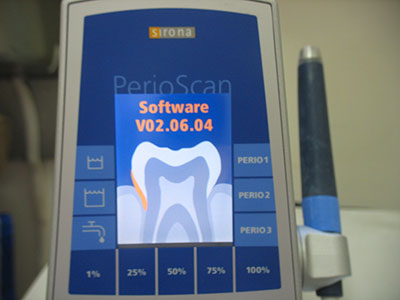 With the help of a unique tool, the PERIOSCAN (device photo).
Its radar, through light and sound signals, is able to identify the deposits under the gums and remove them simultaneously.
With the help of a unique tool, the PERIOSCAN (device photo).
Its radar, through light and sound signals, is able to identify the deposits under the gums and remove them simultaneously.This helps avoid gum surgery in most cases.
10- What is the ultimate purpose of this treatment ?
The goal in getting treated is to establish a permanent healthy oral cavity :
- No bleeding
- Better occlusion for better comfort
- Fix loose teeth – in most cases the gum is rejuvenated around the roots and so is the bone tissue, leading to stronger teeth.
Moreover, in most cases, patients will learn to effectively modify life style habits in order to prevent and protect the gums and teeth, and avoid needing any kind of implants and bridges.
| Before : | After |
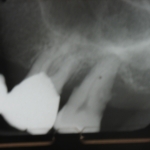 | 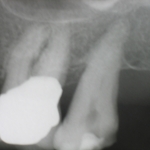 |
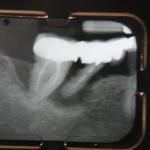 | 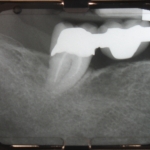 |
11- What happens after one year ? Can the gum disease that was once cured, reappear ?
Yes, and in order to avoid this, regular checkups should be scheduled over the next few years, in order to effectively keep the former infections at bay and monitor the effectiveness of the treatment.
12- Is gum infection contagious ?
Yes, in cases of severe infection, it is contagious through kissing, use of the same toothbrush, cutlery, etc....
13- Is it not normal to have microbes in the mouth ?
It is actually normal to have microbes in the mouth. However there are harmful bacteria, parasites and fungus that should not live in your mouth as they cause infections. The observation of the plaque through the microscope will determine their presence and lead to a diagnosis and treatment.
14- How can one s overall health condition influence gum disease ?
Some general physical conditions have an aggravating influence on gum disease, particularly diabetes and autoimmune weaknesses.
Smoking also endangers your oral cavity. In such instances, treatment will be heavier and require scheduling more visits and checkups.
In addition, pregnancy and breastfeeding can also contribute to periodontal conditions because of the hormonal changes involved.
15- How can gum disease (periodontitis) affect one s overall health condition ?
According to a number of scientific studies, periodontitis may increase the risk of :
• Myocardial infarction.
• High arterial blood pressure.
• Diabetes.
• Premature birth complications.
 עברית
עברית Français
Français English
English